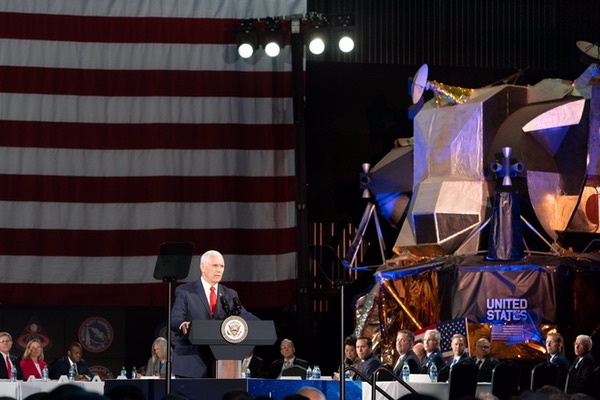Destination Moon: China’s first mover advantage and America’s second mover advantageby John Hickman
|
| The word “Moon” appears 31 times in the text of the speech, and “Mars” only five. Moreover, the American return to the Moon was given an ambitious Kennedy-esque deadline of five years. |
That difference might not survive in practice, but for the moment it reflects strategic decisions analogous to those of competing business firms considering geographic expansion, or in this case selenographic expansion. Marketing economics describes a firm’s decision to steal a march on competitors by investing in a new technology, or by preempting access to a market or location, as a First Mover Advantage.
Selecting the first location in space where humans will take up permanent residence beyond low Earth orbit represents a classic First Move for two reasons. First, decisions about permanent human bases will be made infrequently until space travel becomes more much common. Second, it shapes the decision-making environment for other spacefaring nations and private space firms. Other space agencies and private firms are likely to find a CNSA research base on the surface more attractive than an orbiting NASA platform. Given the “choose a side” nature of this Sino-American space race, other space agency and private investments on modules and personnel at the CNSA base are unlikely to be available for whatever NASA intends to do intermittently on the surface.
Realizing the First Mover Advantage is consistent with Beijing’s valuation of terrestrial territory. The “Century of Humiliation” at the hands of Western imperialism taught China’s rulers to ignore the hypocrisies of liberal internationalism, especially when the subject is sovereignty over geographic space. Han Chinese colonization of Tibet and Xinjiang, together with the construction of entire islands to make good the claim of exotic territorial sovereignty over the South China Sea, leave no doubt that the Middle Kingdom does not like to share.
The Second Mover Advantage is realized when a competing firm free-rides on the investment made by the First Mover. NASA’s lunar Gateway is an excellent instrument for observing what does and does not work for the CNSA at its permanent human base on the lunar surface. CNSA successes can be emulated and CNSA failures avoided. Almost inevitably, historical analogy will be drawn to Europeans exploiting the inventiveness of the Chinese in the medieval and early modern eras.
Pursuing the Second Mover Advantage is also consistent with the bureaucratic conservatism that characterizes mature organizations. NASA plans to build a large space station in lunar orbit rather than a base on the lunar surface because NASA already knows how to build a large space station in orbit. During the 1962 Cuban Missile Crisis, that same “do what you already know how to do well” impulse led the Joint Chiefs of Staff, notably Air Force Gen. Curtis LeMay, to propose a surprise air strike rather than an ultimatum and naval blockade. The decision-making impulse to avoid risk by rejecting anything that departs from proven fields of competence resembles the path dependence characterizing large scale established systems called the network externality familiar in the form of the arbitrary QWERTY keyboard.
| Competitive contests usually involve multiple moves by participants, and there are more decisions to be made about locations for human occupation on the Moon. |
The lunar Gateway also permits Washington avoid even the appearance of a violation of the anti-annexationist prohibition in 1967 Outer Space Treaty. Perhaps there is hope in Washington that orbiting the Moon, rather than permanently occupying the lunar surface, will persuade the Chinese to delay making any claim of territorial sovereignty to the South Pole. More probably, open competition for its most promising permanently shadowed craters will expose the treaty’s liberal international idealist conception of outer space as a res communis, as unsustainable and for the reasons that I identified in 2007 (see “Still crazy after four decades: The case for withdrawing from the 1967 Outer Space Treaty”, The Space Review, September 24, 2007.)
First Mover Advantage and Second Mover Advantage describe the calculated imposition of constraints on subsequent decision-makers. So, over the near term, the south pole of the Moon will now be focus of human exploration, development, and settlement. If the destination disappoints, consolation may be found in the sort of stubborn commitment that rival great powers exhibit when competing for new territory and international prestige. There is also a measure of consolation to be had from conceiving the joint decision as a competitive contest between First Mover and Second Mover. Competitive contests usually involve multiple moves by participants, and there are more decisions to be made about locations for human occupation on the Moon.
Note: we are temporarily moderating all comments subcommitted to deal with a surge in spam.
